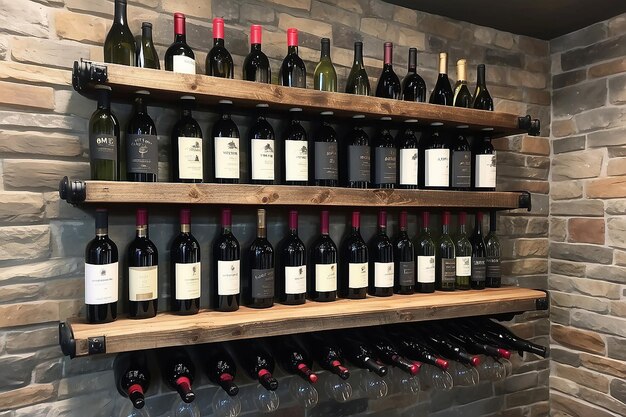The Ideal Temperature for Your Wine Refrigerator: A Complete Guide
Wine lovers and connoisseurs understand that the journey from grape to glass is steeped in tradition, terroir, and time. But what about the moments after you've brought that perfect bottle home? The way you store your wine impacts its taste and longevity – and that begins with temperature. Let's dive into the ideal settings for your wine refrigerator, and ensure your collection maintains its flavor and integrity for years to come.
🍷 Why Temperature Matters in Wine Storage
Temperature plays a crucial role in wine preservation. Too high, and your wine might age prematurely; too low, and you risk losing vibrant flavors and aromas. It's about balance, ensuring each bottle can mature gracefully over time while still being ready to serve when the occasion calls.
The Science Behind Wine Storage Temperature
Wine is a living medium, with chemical reactions continuing to occur after bottling. Temperature fluctuations can accelerate these reactions, potentially leading to spoilage or undesirable changes in flavor. Consistency is key to preventing these fluctuations, making a wine refrigerator an essential tool for enthusiasts.
The Impact of Poor Temperature Control
When wines are exposed to the wrong temperatures, several things can happen:
- Premature Aging: Wines may develop an overly mature taste if stored too warm.
- Flavor Loss: Cool temperatures can flatten the nuances of delicate whites and reds.
- Spoilage: Extreme conditions can cause cork shrinkage or expansion, leading to oxidation.
Ideal Storage Temperatures for Different Wines
🍇 Red Wines
Red wines generally prefer warmer temperatures compared to their white counterparts. The ideal range for storing red wines is between 55°F to 65°F (13°C to 18°C). Within this spectrum:
- Light and Fruity Reds: Closer to 55°F (13°C).
- Full-bodied Reds: Toward 65°F (18°C).
🍋 White Wines
White wines are best kept cooler to preserve their fresh, crisp characteristics. They should ideally be stored at 45°F to 55°F (7°C to 13°C):
- Lighter Whites: Closer to 45°F (7°C).
- Richer Whites: Nearer to 55°F (13°C).
🍾 Sparkling Wines and Champagne
Effervescent wines and champagnes are especially sensitive to warmth, hence best kept at temperatures ranging from 40°F to 50°F (4°C to 10°C):
- Daily Enjoyment: Around 40°F (4°C).
- Aging Purpose: Toward 50°F (10°C).
Key Factors to Consider for Wine Refrigeration
Consistency Over Perfection
The overarching goal for wine storage isn't achieving a specific temperature but maintaining that temperature consistently. Thermal instability can be more damaging than minor deviations from the perfect degree.
Humidity Control
While temperature is crucial, maintaining appropriate humidity levels is vital. It helps keep corks moist, preventing exposure to harmful oxygen. Aim for a humidity level of 50% to 70% in your wine fridge for optimal conditions.
UV Light Prevention
UV rays can degrade and prematurely age your wines. Consider choosing refrigerators with UV-protected doors or positioning your fridge away from direct sunlight to safeguard your investment.
Types of Wine Refrigerators
For those new to wine collecting, understanding the types of wine refrigerators available can enhance your storage strategy.
Single-Zone Wine Refrigerators
These units maintain one consistent temperature throughout and are ideal for:
- Collectors of a specific wine type (e.g., all reds or all whites).
- Simple setups without the complexity of juggling different temperatures.
Dual-Zone Wine Refrigerators
Perfect for those with diverse collections, these fridges allow:
- Separate compartments for reds and whites, ensuring both are stored at optimal conditions.
- More flexibility in aging and serving-ready availability.
Practical Tips for Optimizing Your Wine Refrigerator
🛠️ Setup and Placement Tips
- Level Surface: Ensure your wine fridge sits on an even surface to prevent vibrations that can disturb sediment.
- Adequate Ventilation: Place away from heat sources and ensure vent clearance for proper airflow.
Organization and Labeling
Organize your bottles with labels or tags that highlight not only the wine type but also the date of purchase and suggested opening window. This practice aids not just in ease of access but also in consuming wines when they're at their peak.
Routine Maintenance
Regularly check the temperature settings and clean the shelves and coils to ensure efficient operation and prevent mold from compromising cork integrity.
Frequently Asked Questions About Wine Fridges
❓ What Temperature Should I Serve Wine?
- Reds: Slightly below room temperature, around 60°F (16°C).
- Whites and Sparkling: Best served chilled, between 40°F and 50°F (4°C and 10°C).
❓ Can I Use a Regular Refrigerator for Wine?
While a household fridge can temporarily store wine, it's not recommended for long-term preservation due to low humidity and frequent temperature alterations from regular opening and closing.
Summarized Takeaways for Wine Refrigerator Settings
To make your wine refrigerator setup seamless and effective, keep this quick guide handy:
- Red Wines: Store at 55°F – 65°F (13°C – 18°C)
- White Wines: Keep at 45°F – 55°F (7°C – 13°C)
- Sparkling Wines: Best at 40°F – 50°F (4°C – 10°C)
- Humidity: Maintain between 50% – 70%
- Consistency: Prioritize consistency in temperature to safeguard flavor
- Dual-Zone Fridges: Ideal for diverse wine collections
- Prevent UV Exposure: Limit light exposure for optimal preservation 🌞🚫
Understanding and maintaining the right temperature settings in your wine refrigerator is more than a matter of preference – it's a commitment to the quality and enjoyment of each bottle you open. Whether you're appreciating the unique characteristics of a vintage red or the refreshing crispness of a favorite white, temperature is a trusted ally in ensuring your wine experiences are everything you want them to be. Cheers to perfect preservation!
